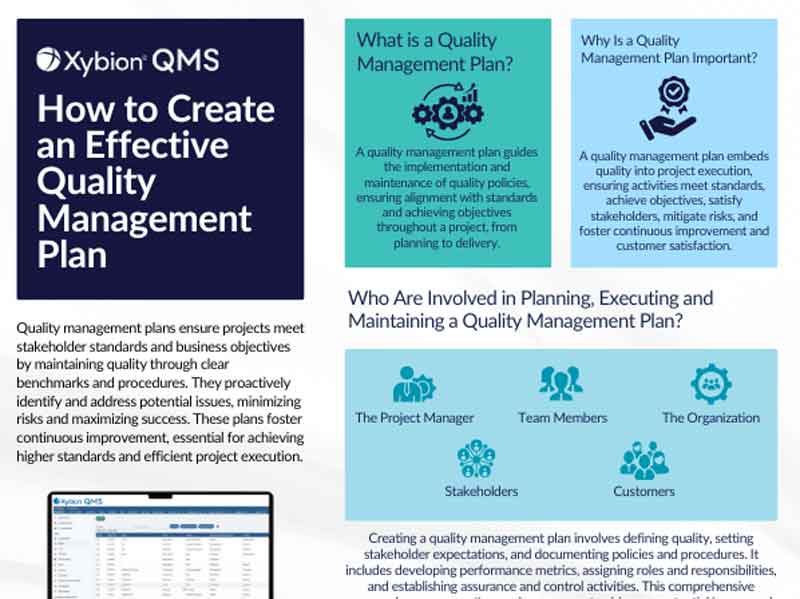Importance of Quality Management Plan:
Ensuring Project Success and Continuous Improvement
Quality management plans are critical frameworks that ensure projects meet the required standards and expectations of stakeholders. They encompass a series of processes and actions aimed at maintaining quality throughout the project lifecycle. By establishing clear benchmarks and procedures, these plans help in aligning the project outcomes with business objectives, thereby ensuring efficiency and effectiveness in execution.
A well-crafted quality management plan identifies potential issues before they become significant problems and also provides a structured approach to addressing them. This proactive stance on quality assurance helps in minimizing risks and maximizing project success. It sets the foundation for continuous improvement, making it possible to achieve higher standards over time. Understanding the importance of these plans and how they can be developed and implemented effectively is crucial for any project management team. Through this exploration, we aim to provide insights into the creation of robust quality management plans that can withstand the challenges of any project environment.
Purpose of a Quality Management Plan
A Quality Management Plan (QMP) provides a roadmap for ensuring that project deliverables meet defined standards. It helps teams avoid errors, improve efficiency, and align everyone around a shared vision of quality.
Key benefits include:
- Consistency in processes and outcomes
- Early identification of risks and issues
- Clear accountability across stakeholders
Key Components of a Quality Management Plan
A strong QMP covers the essential elements that guide a project from start to finish. These components establish structure and ensure nothing important is overlooked.
Core elements often include:
- Business case: Why quality matters for the project’s success
- Regulatory requirements: Standards and rules that must be met
- Communication strategy: How information is shared within the team and with stakeholders
- Quality processes: Steps to monitor, measure, and improve quality
Each component should be tailored to the specific project and industry. For example, a pharmaceutical project may place heavy emphasis on regulatory compliance, while a software project may prioritize testing cycles and customer feedback. The strength of the plan lies in how well these components reflect the real needs of the project.
Roles and Responsibilities in Quality Management
Quality management is a shared responsibility that requires participation from multiple stakeholders. Each role has unique contributions to the plan’s success.
Examples of key roles:
- Project Manager: Oversees execution of the plan and ensures compliance
- Team Members: Apply quality processes in daily work
- Stakeholders & Customers: Define expectations and provide feedback
- Quality Assurance (QA): Monitors standards, conducts audits, and recommends improvements
Clearly defining roles prevents confusion and duplication of effort. When everyone understands their responsibilities, the project runs more smoothly, and accountability is easier to enforce. This clarity also builds trust among stakeholders, as they know their input and oversight are being addressed within the plan.
Execution and Continuous Improvement
A QMP is only effective when it’s put into action. Teams must follow documented processes, conduct regular testing, and use audits as feedback to refine their approach.
Practical steps include:
- Assigning clear roles and approval workflows
- Scheduling regular quality checks and audits
- Using tools like Quality Management Systems (QMS) to track progress
- Updating the plan based on lessons learned and evolving requirements
Continuous improvement ensures the plan stays relevant as projects evolve. Lessons learned from audits, customer feedback, and project reviews should be used to adapt processes. Over time, this creates a culture of quality where improvement is not a one-time event but an ongoing commitment.
Xybion QMS – the Perfect Solution
Implementing a Quality Management Plan is easier and more effective with the right tools, and that’s where Xybion QMS comes in. As a fully integrated quality management system, it helps organizations automate:
- Compliance processes
- Streamline document control
- Manage audits
- Track corrective and preventive actions (CAPA)
With its flexible and scalable design, Xybion QMS adapts to your unique business requirements, ensuring that quality standards are not only met but continuously improved. This makes it the ideal partner for any organization looking to maintain efficiency, meet regulatory requirements, and build a culture of quality.













